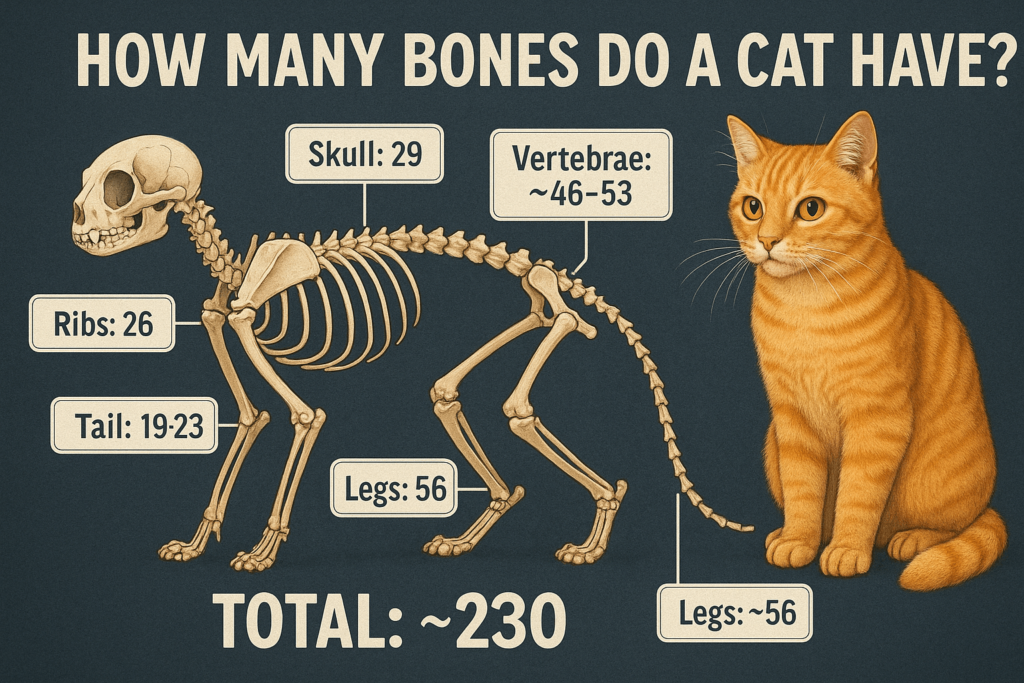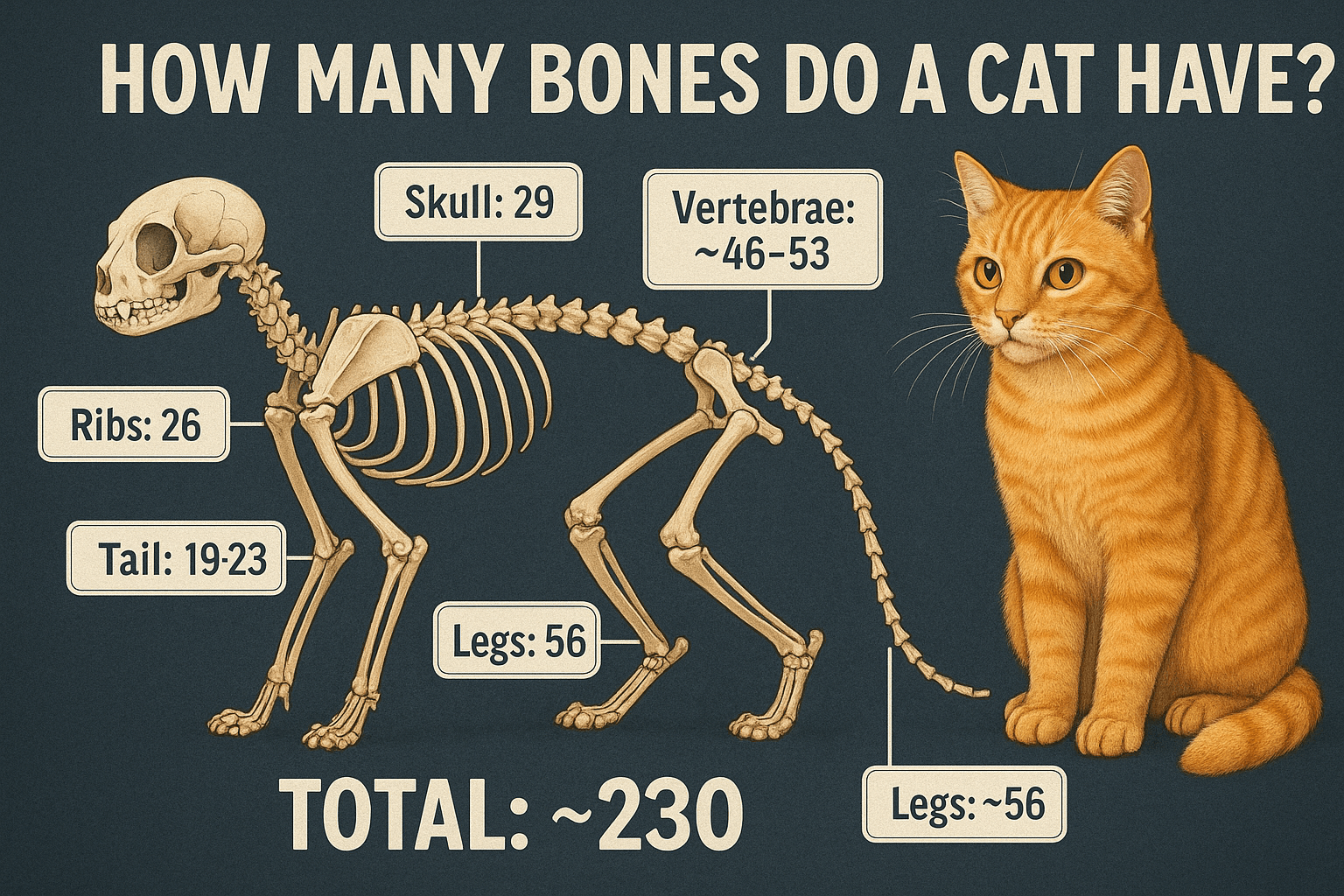How Many Bones Do a Cat Have?
Cats are fascinating creatures, known for their agility, flexibility, and graceful movements. But have you ever wondered how many bones a cat has and what makes their skeletal structure so unique? Understanding the anatomy of your feline friend not only satisfies curiosity but also helps you appreciate their incredible abilities. From their ability to squeeze into tight spaces to their impressive leaps and landings, a cat’s skeleton plays a crucial role in their everyday activities. In this blog post, we’ll explore the number of bones in a cat’s body, the functions of these bones, and how they contribute to your cat’s remarkable behavior.
The Number of Bones in a Cat’s Body
A cat’s skeleton is both intricate and adaptable, designed to support their agile lifestyle. The number of bones can vary slightly depending on factors like tail length and individual traits, but here’s a general breakdown of what makes up a cat’s skeletal system.
Average Number of Bones:
Most cats have around 244 bones in their body, which is more than humans, who typically have 206 bones.Tail Bones (Caudal Vertebrae):
A cat’s tail contains between 18 to 23 vertebrae, contributing to its flexibility and balance during movement.Spine (Vertebrae):
Cats have 30 to 53 vertebrae in their spine, depending on tail length. Their highly flexible spine allows them to twist and turn with ease.Collarbone (Clavicle):
Unlike humans, cats have a small, floating collarbone that enables them to squeeze through narrow spaces.Skull and Limbs:
A cat’s skull contains around 29 bones, while their limbs include long bones like the femur and radius, essential for jumping and running.
The combination of these bones gives cats their signature flexibility and athleticism, making them one of nature’s most agile predators.

Functions of a Cat’s Skeletal System
Each bone in a cat’s body serves a specific purpose, contributing to their overall health and functionality. Here’s how the skeletal system supports your cat’s daily life.
Supporting Movement:
The bones in a cat’s legs and spine provide the foundation for their powerful leaps and swift sprints.Protecting Vital Organs:
The ribcage shields the heart and lungs, while the skull protects the brain and sensory organs.Facilitating Flexibility:
The unique structure of a cat’s vertebrae allows them to twist their bodies mid-air, ensuring safe landings.Enabling Balance:
Tail bones help cats maintain balance, especially when walking on narrow surfaces or landing from heights.Assisting in Hunting:
The jaw and teeth bones are adapted for gripping and tearing prey, showcasing their predatory instincts.
Understanding these functions highlights the importance of maintaining your cat’s skeletal health throughout their life.
Check this guide 👉Understanding Pregnant Cat Anatomy: Best 7 Expert Tips!
Check this guide 👉Understanding Cat Teeth Anatomy: Best 7 Health Tips!
Check this guide 👉Cat Ear Anatomy: Best 7 Health Tips!
Key Features of a Cat’s Skeleton | Benefits to Your Cat |
|---|---|
Highly flexible spine | Enables impressive acrobatics and agility |
Floating collarbone | Allows squeezing into tight spaces |
Strong leg bones | Supports powerful jumps and fast runs |
Tail vertebrae | Enhances balance and communication |
Protective ribcage | Safeguards vital organs during activity |
Differences Between a Cat’s Skeleton and a Human’s
While cats and humans share some similarities in their skeletal systems, there are significant differences that explain why cats move and behave so differently.
Number of Bones:
Cats generally have more bones than humans, particularly in their spine and tail, which enhances their flexibility.Shape of the Spine:
A cat’s spine is more elastic, allowing for greater range of motion compared to the rigid human spine.Floating Collarbone:
Unlike humans, cats lack a fixed collarbone, enabling them to fit through openings as wide as their head.Tail Structure:
Humans do not have tails, while a cat’s tail plays a vital role in balance and communication.Bone Density:
Cats have lighter, more delicate bones compared to humans, which contributes to their speed and agility.
These differences highlight the evolutionary adaptations that make cats such extraordinary animals.
How to Keep Your Cat’s Bones Healthy
Maintaining your cat’s skeletal health is essential for their overall well-being. Here are some tips to ensure their bones stay strong and functional.
Provide a Balanced Diet:
Ensure your cat’s diet includes adequate calcium, phosphorus, and vitamin D to support bone strength.Encourage Exercise:
Regular playtime and physical activity help keep your cat’s muscles and bones in good condition.Monitor Weight:
Excess weight can strain your cat’s bones and joints, so maintaining a healthy weight is crucial.Schedule Vet Checkups:
Routine veterinary visits can detect early signs of bone or joint issues, such as arthritis.Minimize Falls:
Prevent accidents by securing windows and balconies to avoid injuries from high falls.
By following these guidelines, you can help your cat enjoy a long, active life with a strong and healthy skeleton.
How a Cat’s Bones Support Their Hunting Instincts
A cat’s hunting prowess relies heavily on their skeletal system, which is finely tuned for stalking, pouncing, and capturing prey. These adaptations make them natural-born hunters.
Flexible Spine for Pouncing:
The elasticity of a cat’s spine allows them to crouch low and spring forward with precision.Powerful Hind Legs:
Strong leg bones provide the force needed for explosive jumps and rapid acceleration.Sharp Claws and Forelimbs:
The bones in a cat’s forelimbs work with their retractable claws to grip and hold onto prey securely.Jaw Structure for Biting:
A cat’s jawbones are designed for delivering a quick, fatal bite to their target.Lightweight Frame for Stealth:
Their slender bones reduce noise and allow them to move silently while stalking prey.
These features demonstrate how a cat’s skeleton is perfectly suited for their role as skilled hunters.
Fun Facts About a Cat’s Skeleton
Beyond their basic anatomy, a cat’s skeleton holds many intriguing facts that showcase their uniqueness. Here are some fun tidbits to impress fellow cat lovers.
Extra Lumbar Vertebrae:
Cats have more lumbar vertebrae than humans, giving them superior flexibility and jumping power.Tail as a Mood Indicator:
A cat’s tail bones help express emotions, from happiness (upright) to fear (puffed up).Ability to Land on Feet:
The unique structure of a cat’s vertebrae allows them to rotate mid-air and land upright—a phenomenon called the “righting reflex.”Unique Skull Shape:
A cat’s skull is shorter and rounder than a dog’s, accommodating their large eyes and keen sense of smell.Kittens’ Unfused Bones:
Kittens are born with soft, unfused bones that harden as they mature, allowing for growth and development.
These fun facts reveal just how extraordinary a cat’s skeleton truly is.
Common Myths About a Cat’s Bones
Several myths surround a cat’s skeleton, often stemming from misunderstandings about their anatomy. Let’s debunk some of these misconceptions.
Cats Always Land on Their Feet Without Injury:
While cats have a remarkable ability to right themselves, they can still suffer injuries from falls, especially from great heights.All Cats Have the Same Number of Bones:
The number of bones varies slightly based on breed, size, and tail length.Cats Don’t Get Arthritis:
Cats are prone to arthritis as they age, though symptoms may be less obvious than in dogs.A Broken Bone Heals Quickly in Cats:
While cats heal faster than some animals, fractures still require proper veterinary care to ensure full recovery.Cats’ Bones Are Indestructible:
Despite their agility, cats’ bones are delicate and can break under significant force or trauma.
Dispelling these myths helps foster a better understanding of a cat’s skeletal health and vulnerabilities.
Frequently Asked Questions About a Cat’s Bones
Why do cats have more bones than humans?
Cats have additional bones in their spine and tail, which contribute to their flexibility and agility.
Can a cat survive without its tail?
Yes, cats can live without a tail, though it may affect their balance and communication abilities.
Do kittens have more bones than adult cats?
Yes, kittens are born with more bones due to unfused vertebrae, which fuse as they grow older.
What causes brittle bones in cats?
Nutritional deficiencies, aging, or certain medical conditions can lead to weakened bones in cats.
How can I tell if my cat has a broken bone?
Signs include limping, swelling, reluctance to move, or vocalizing in pain. Consult a vet immediately if you suspect an injury.
Appreciating the Complexity of a Cat’s Skeleton
A cat’s skeletal system is a marvel of nature, perfectly adapted to support their agile and independent lifestyle. By understanding how many bones a cat has and the roles these bones play, you gain a deeper appreciation for your feline companion’s incredible abilities. Whether it’s their ability to leap gracefully or squeeze into impossible spaces, every movement reflects the wonders of their skeletal structure. As a responsible pet owner, taking steps to care for their bones ensures they remain healthy, happy, and active throughout their lives.
Can a Cat Die from a Cold? Best 7 Expert Tips! Learn how to identify, treat, and prevent feline colds while understanding when to seek veterinary care for your cat’s health.
Cat Screaming for Food: Best 7 Expert Tips! Discover effective strategies to manage your cat's food-related vocalizations and create a peaceful feeding routine.
Aspiration Pneumonia in Cats: Best 7 Expert Tips! Discover causes, symptoms, and treatment advice to protect your cat’s respiratory health and ensure a speedy recovery.
Hip Dysplasia in Cats: Best 7 Expert Tips! Discover expert advice on managing hip dysplasia in cats, from symptoms and prevention to treatment options for a happier, healthier feline life.





